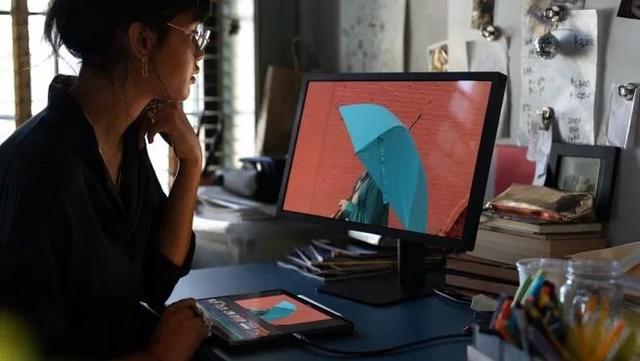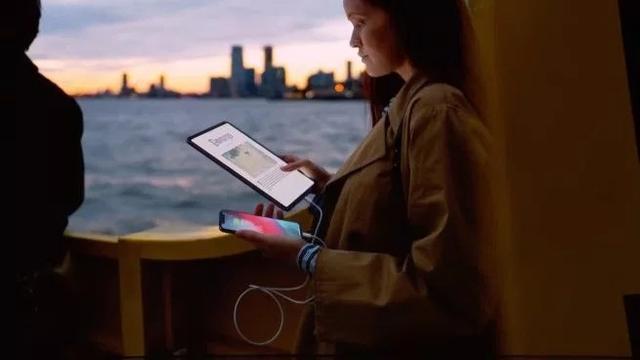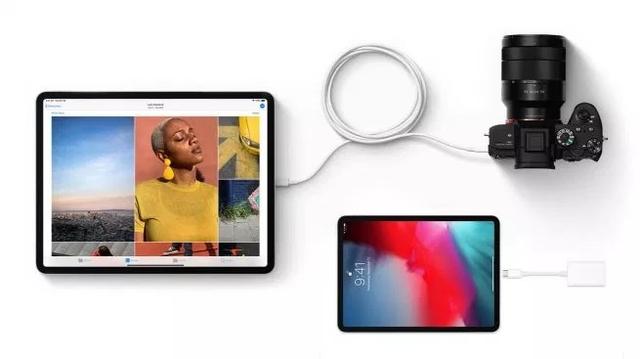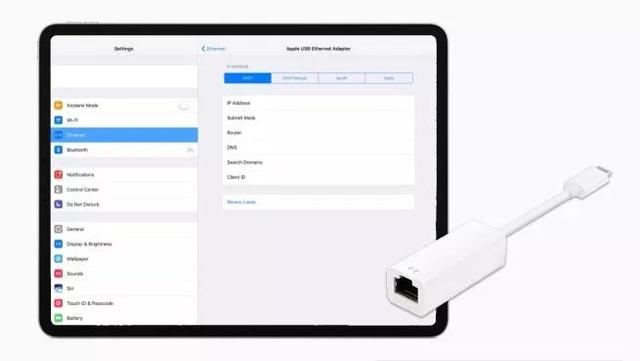 Computer Tutorials
Computer Tutorials
 Computer Knowledge
Computer Knowledge
 The resolution changes when a USB disk is inserted into the computer
The resolution changes when a USB disk is inserted into the computer
The resolution changes when a USB disk is inserted into the computer
php editor Strawberry is here to introduce you to a common problem - when we insert a USB flash drive into the computer, we sometimes find that the screen resolution suddenly changes. This situation may lead to poor display effects and affect our user experience. In the following article, we will answer this question for you and provide solutions so that you can easily deal with this trouble.
The USB-C connector plays an important role on Apple's laptops. With the exception of the 12-inch MacBook, all USB-C ports are Thunderbolt 3 ports, which means they have extremely fast bandwidth and throughput. Thunderbolt 3 is capable of driving multiple displays simultaneously and offers a wealth of connectivity options on a single port. This allows users to easily connect external displays, storage devices, external GPUs and other peripherals. Whether for work or entertainment, USB-C connectors provide efficient and convenient solutions.
The iPad Pro doesn’t have Thunderbolt, it has a USB-C 3.1 Gen 2 port. This means it can transmit up to 10Gbps, which allows the iPad to drive a 5K display at 60 frames per second.
Connect an external display:

The new iPad Pro features the ability to connect directly to a USB-C display and communicate via the DisplayPort standard. You simply plug one end into your iPad and the other into an external display with a USB-C port, such as the 4K LG UltraFine Display. The iPad also supports HDR10 output, making it possible to take advantage of available high dynamic range displays, such as the 27-inch LG 27UK850. This feature gives iPad Pro greater flexibility and precision in image and video editing. Whether for work or play, iPad Pro connected to an external display delivers a better visual experience.
The iPad can output via screen mirroring, which means some apps can take advantage of the additional screen output capabilities. For example, using the Keynote app, you can display a live presentation on your iPad and play the audio through the external display's speakers. Additionally, you can connect your iPad to your TV to watch Netflix movies on the big screen. It's important to note that the flexibility of this approach is somewhat limited compared to when connecting a second monitor to your Mac.
Somewhat annoyingly, you can't use the USB-C cable that comes with the iPad. You need a USB cable that supports a "high bandwidth" connection. If you don't have such a cable, Apple recommends purchasing a Thunderbolt 3 cable from the Apple Store to solve this problem. You can buy this cable from Belkin for $10, and it's backwards compatible with high-bandwidth USB-C connections even if the iPad doesn't support Thunderbolt.
The iPad can output to a 5K display, however, the LG 5K UltraFine display sold by Apple is not compatible. Why? It has a USB-C connector, but it's a Thunderbolt 3 display, and the iPad doesn't support Thunderbolt. 5K USB-C monitors are very scarce right now, and we don't have any good recommendations yet.
If you want to connect to a display without a USB-C port (such as HDMI), you will need to use an adapter. The adapter allows the iPad Pro to output HDMI 2.0 specifications, supporting a maximum resolution of 4K at 60Hz. Although it's not confirmed yet, it could theoretically output HDR10 and Dolby Vision with compatible adapters as well.
Charge other devices:

The USB-C port on iPad Pro delivers up to 7.5W charging speeds for connected devices. If you have a USB-C to Lightning cable, you can plug in your iPhone and use your iPad to charge your iPhone. If you have two new iPad Pros, you can use the included USB-C to USB-C cable to connect them together and charge the other. One iPad will draw power from another iPad at the same time.
Apple recently released a USB-C cable for the Apple Watch, so you can even charge your Apple Watch on the go.
Get photos and videos from external storage:

iPad does not support universal external storage. You can't plug in a USB-C flash drive and view the files in the Files app. This is an operating system limitation that many expected Apple to address in a future software update, but that's not possible now.
However, you can use the Photos app to import photos and videos from USB storage. If you happen to have a bunch of photos on a USB hard drive, you can connect it to your iPad and use the Import tab in the Photos app to absorb the photos and videos.
This also applies to cameras. Many cameras come with USB-C or mini USB ports. As long as you have the right adapter or cable, you can shoot with your camera and instantly connect it to your iPad to import files and see your photos on the big screen.
The same is true for SD card import. Apple now offers its own USB-C to SD card reader. Plug it into your iPad Pro and insert the SD card to enable photo and video import. It even supports using UHS-II cards for fast transfers. Since USB is an open standard, you can find cheaper SD card USB-C adapters if Apple's official product is too expensive.
Connect keyboard and wired network:

There are drivers for many basic types of USB accessories for iPad. iOS doesn't let you install additional drivers, but it supports a large number of basic external devices that can plug and play with your computer.
Take the keyboard, if you have a USB-A keyboard, you can use a USB-C adapter and plug it in and the iPad will detect it. Another thing the iPad supports is Ethernet, so if you don't have access to WiFi, your iPad can actually use a wired network. You can use a USB-C Ethernet adapter to connect Gigabit Ethernet to your iPad Pro. When the setup is detected, the iOS setup screen will magically display the new section for Ethernet.
Connect speakers, microphones, and other audio devices:
The iPad doesn’t have a headphone jack, so you can use the $9 Apple USB-C Headphone Jack Adapter to plug in wired headphones or speakers. If you have USB-C headphones, they will plug right in and work fine.
You can also use USB to connect audio devices such as a MIDI keyboard or microphone. In some cases, the 7.5 watts the iPad outputs through the port are enough to power smaller accessories, so you only need a USB-C cable. It will work as long as the USB bus has enough power support.
Connect to a multi-interface HUB:
USB-C bandwidth is high enough that you can drive multiple accessories at once through a single port. You can mix and match all of the above at the same time - photo import, display, microphone and more, all it takes is a suitable hub, and there are loads of options on the market. The Apple USB-C Digital AV Multiport Adapter is a hub in its own right, offering HDMI, power input, and a spare USB-A port for backup connectivity. The extra bandwidth of USB-C also enables some things that weren't possible before. You can now connect a 4K monitor and camera at the same time, or a single 5K monitor with a 60Hz refresh rate. 7.5W charging is also new.
This article is compiled from 9to5Mac.
The above is the detailed content of The resolution changes when a USB disk is inserted into the computer. For more information, please follow other related articles on the PHP Chinese website!

Hot AI Tools

Undresser.AI Undress
AI-powered app for creating realistic nude photos

AI Clothes Remover
Online AI tool for removing clothes from photos.

Undress AI Tool
Undress images for free

Clothoff.io
AI clothes remover

Video Face Swap
Swap faces in any video effortlessly with our completely free AI face swap tool!

Hot Article

Hot Tools

Notepad++7.3.1
Easy-to-use and free code editor

SublimeText3 Chinese version
Chinese version, very easy to use

Zend Studio 13.0.1
Powerful PHP integrated development environment

Dreamweaver CS6
Visual web development tools

SublimeText3 Mac version
God-level code editing software (SublimeText3)

Hot Topics
 1389
1389
 52
52
 What is the reason why PS keeps showing loading?
Apr 06, 2025 pm 06:39 PM
What is the reason why PS keeps showing loading?
Apr 06, 2025 pm 06:39 PM
PS "Loading" problems are caused by resource access or processing problems: hard disk reading speed is slow or bad: Use CrystalDiskInfo to check the hard disk health and replace the problematic hard disk. Insufficient memory: Upgrade memory to meet PS's needs for high-resolution images and complex layer processing. Graphics card drivers are outdated or corrupted: Update the drivers to optimize communication between the PS and the graphics card. File paths are too long or file names have special characters: use short paths and avoid special characters. PS's own problem: Reinstall or repair the PS installer.
 How to speed up the loading speed of PS?
Apr 06, 2025 pm 06:27 PM
How to speed up the loading speed of PS?
Apr 06, 2025 pm 06:27 PM
Solving the problem of slow Photoshop startup requires a multi-pronged approach, including: upgrading hardware (memory, solid-state drive, CPU); uninstalling outdated or incompatible plug-ins; cleaning up system garbage and excessive background programs regularly; closing irrelevant programs with caution; avoiding opening a large number of files during startup.
 How to solve the problem of loading when PS is always showing that it is loading?
Apr 06, 2025 pm 06:30 PM
How to solve the problem of loading when PS is always showing that it is loading?
Apr 06, 2025 pm 06:30 PM
PS card is "Loading"? Solutions include: checking the computer configuration (memory, hard disk, processor), cleaning hard disk fragmentation, updating the graphics card driver, adjusting PS settings, reinstalling PS, and developing good programming habits.
 Is slow PS loading related to computer configuration?
Apr 06, 2025 pm 06:24 PM
Is slow PS loading related to computer configuration?
Apr 06, 2025 pm 06:24 PM
The reason for slow PS loading is the combined impact of hardware (CPU, memory, hard disk, graphics card) and software (system, background program). Solutions include: upgrading hardware (especially replacing solid-state drives), optimizing software (cleaning up system garbage, updating drivers, checking PS settings), and processing PS files. Regular computer maintenance can also help improve PS running speed.
 How to solve the problem of loading when the PS opens the file?
Apr 06, 2025 pm 06:33 PM
How to solve the problem of loading when the PS opens the file?
Apr 06, 2025 pm 06:33 PM
"Loading" stuttering occurs when opening a file on PS. The reasons may include: too large or corrupted file, insufficient memory, slow hard disk speed, graphics card driver problems, PS version or plug-in conflicts. The solutions are: check file size and integrity, increase memory, upgrade hard disk, update graphics card driver, uninstall or disable suspicious plug-ins, and reinstall PS. This problem can be effectively solved by gradually checking and making good use of PS performance settings and developing good file management habits.
 How to get watermarks from PS
Apr 06, 2025 pm 10:24 PM
How to get watermarks from PS
Apr 06, 2025 pm 10:24 PM
You can use online tools, image editing software, video editing software, and watermark removal applications. Specific methods include: using online tools, using cloning stamp tools, copying stamp tools and repairing brush tools, using blur tools, cropping tools and content-aware fill tools, and using watermark removal applications. Make sure you have the right to do so before removing the watermark.
 How to use mysql after installation
Apr 08, 2025 am 11:48 AM
How to use mysql after installation
Apr 08, 2025 am 11:48 AM
The article introduces the operation of MySQL database. First, you need to install a MySQL client, such as MySQLWorkbench or command line client. 1. Use the mysql-uroot-p command to connect to the server and log in with the root account password; 2. Use CREATEDATABASE to create a database, and USE select a database; 3. Use CREATETABLE to create a table, define fields and data types; 4. Use INSERTINTO to insert data, query data, update data by UPDATE, and delete data by DELETE. Only by mastering these steps, learning to deal with common problems and optimizing database performance can you use MySQL efficiently.
 Can mysql run on android
Apr 08, 2025 pm 05:03 PM
Can mysql run on android
Apr 08, 2025 pm 05:03 PM
MySQL cannot run directly on Android, but it can be implemented indirectly by using the following methods: using the lightweight database SQLite, which is built on the Android system, does not require a separate server, and has a small resource usage, which is very suitable for mobile device applications. Remotely connect to the MySQL server and connect to the MySQL database on the remote server through the network for data reading and writing, but there are disadvantages such as strong network dependencies, security issues and server costs.



